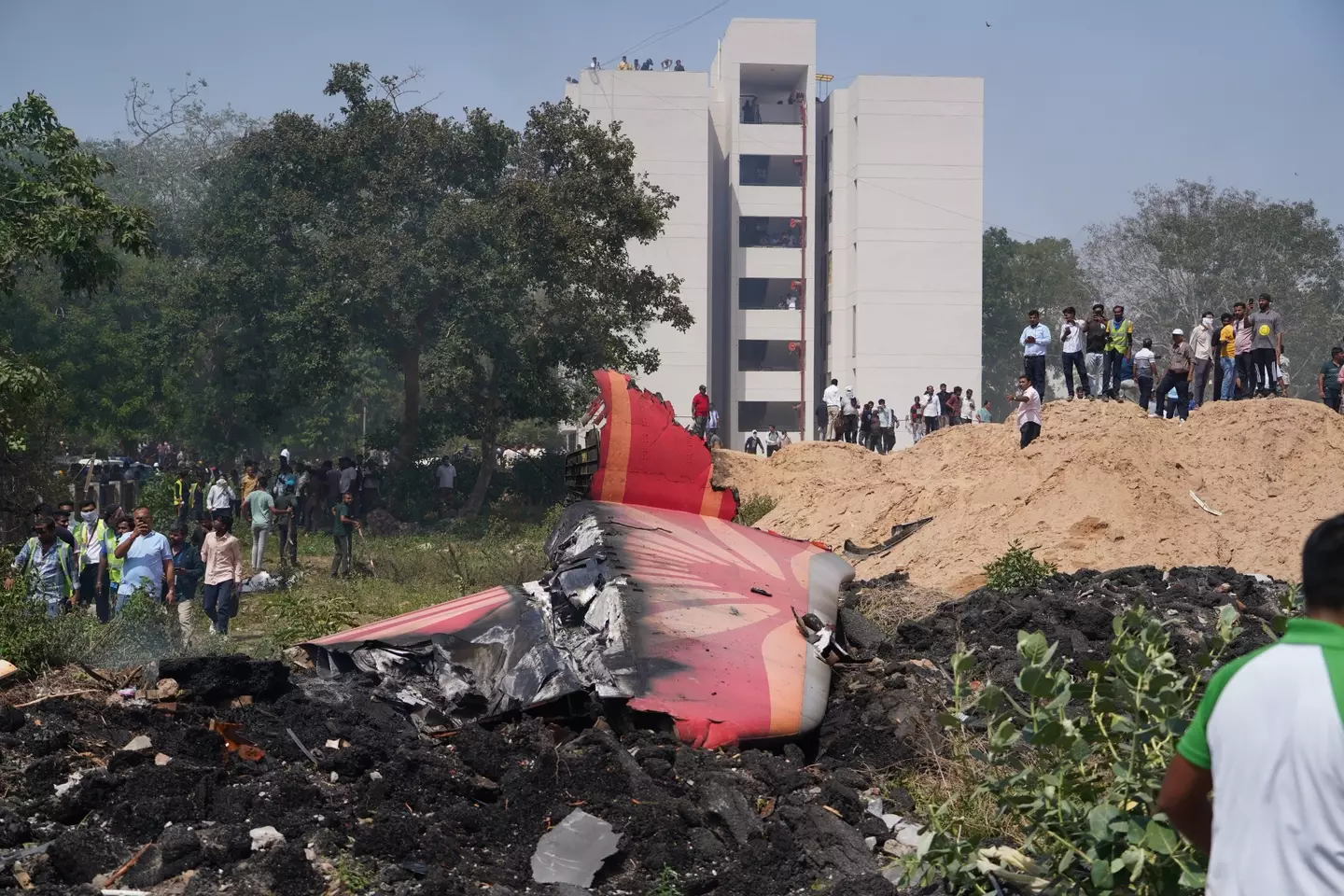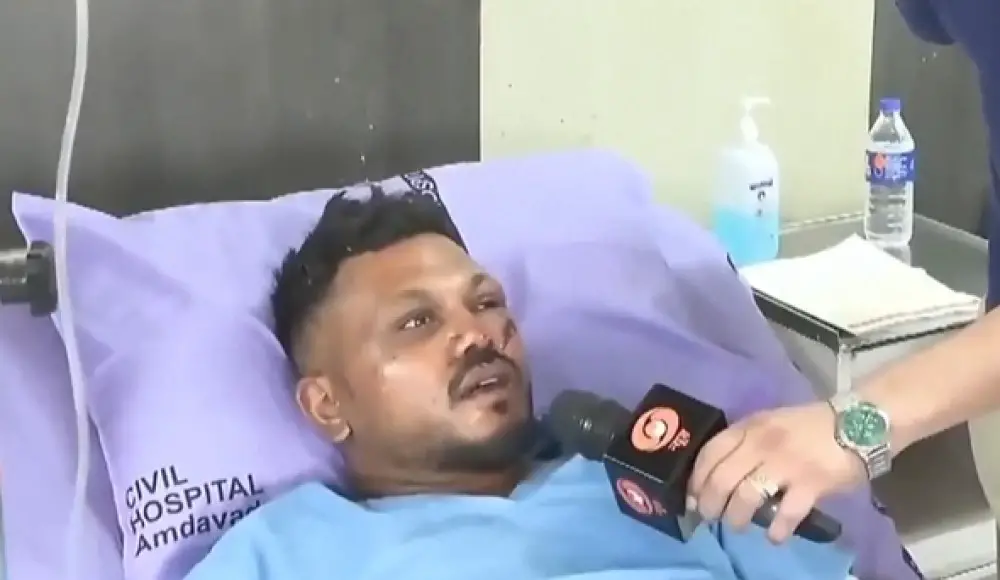Against All Odds: The Miraculous Survival Story of Air India Flight 171
In the space of just thirty seconds, what began as a routine journey home became one of the most catastrophic aviation disasters in recent memory. Yet from the wreckage and flames that claimed 241 lives emerged a story that defied all expectations—the remarkable survival of one man against impossible odds.
The Flight That Never Made It Home
On Thursday, June 12, 2025, Air India Flight 171 departed Ahmedabad’s Sardar Vallabhbhai Patel International Airport at 1:39 p.m. local time, bound for London Gatwick with 242 souls aboard. The Boeing 787-8 Dreamliner carried 230 passengers and 12 crew members, including 169 Indian nationals, 53 British nationals, seven Portuguese nationals, and one Canadian.
What should have been a routine eight-hour journey to London ended in tragedy within minutes of takeoff. The aircraft reached an altitude of only 625 feet when the pilot issued a mayday call for help, and the airliner started to go down. Video captured the moment the aircraft, gaining altitude after just taking off, suddenly began to descend in mid air, before crashing down in a huge plume of fire and smoke.
The plane crashed into residential buildings in the Meghaninagar area near the airport, specifically striking the cafeteria of a hostel for students of the BJ Medical College and Civil Hospital. The impact and subsequent fire created a scene of devastation that would haunt first responders and investigators for days to come.

Footage shows he managed to escape the wreckage (Republic)
The Sole Survivor: Vishwash Kumar Ramesh
Amid the wreckage and flames, one man emerged alive: Vishwash Kumar Ramesh, a 40-year-old British national of Indian origin who had been seated in 11A. His survival from what aviation experts described as a virtually unsurvivable crash has been called nothing short of miraculous.
Ramesh had been visiting family in India and was returning to the UK with his brother, who had been sitting in a different row. The father of one from Leicester had made this journey countless times before, but this trip would end in unimaginable tragedy and an inexplicable stroke of fortune.
Speaking from his hospital bed at Ahmedabad Civil Hospital, where he was being treated for multiple injuries, Ramesh described those terrifying final moments with remarkable clarity. “Thirty seconds after takeoff, there was a loud noise and then the plane crashed. It all happened so quickly”, he told the Hindustan Times.
The Critical Moments of Escape
The sequence of events that allowed Ramesh to survive began with his seat assignment. Ramesh was sitting in seat 11A — a window seat in the emergency exit row of standard economy — according to a passenger list released by the airline. This location, just in front of the plane’s left wing, would prove crucial to his survival.
Ramesh said his part of the plane landed “on the ground floor” of the hostel — and he noticed the emergency door was broken by the impact. In those critical seconds after the crash, while fire began to consume the aircraft and toxic smoke filled the cabin, Ramesh made the split-second decisions that would save his life.
“I managed to unbuckle myself, used my leg to push through that opening, and crawled out”, he explained to Indian state media DD News. “When my door broke, I saw there was a bit of space,” Ramesh said. “So I tried to get out and I was able to get out”.
In a clarification that underscored just how close he came to the ground, Ramesh told The Hindu that he hadn’t needed to jump out of the plane: “I just walked out”. He said his hand was burned by the flames as he fled from the aircraft, but he managed to get far enough away before the fire could cause more serious injuries.

(Siddharaj Solanki/Bloomberg via Getty Images)
The Harrowing Scene Inside
Ramesh’s account of what he witnessed inside the aircraft paints a horrific picture of the crash’s immediate aftermath. “When I got up, there were bodies all around me. I was scared. I stood up and ran. There were pieces of the plane all around me”, he recounted to the Hindustan Times.
The psychological trauma of what he witnessed was evident in his voice as he spoke to reporters. “I saw people dying in front of my eyes – the air hostesses, and two people I saw near me,” he told the Indian broadcaster. “For a moment, I felt like I was going to die too, but when I opened my eyes and looked around, I realised I was alive”.
“I don’t know how I managed to escape,” Ramesh said, adding that he saw other passengers die in front of him. The randomness of survival in such disasters became starkly apparent—inches and seconds separating life from death in ways that defy rational explanation.
The Immediate Aftermath
Video shared by Indian media shows Ramesh, in a white T-shirt smeared with what looks like blood and dirt, limping toward an ambulance. The footage, which quickly went viral on social media, captured a man in shock, moving away from a scene of unimaginable destruction with the stunned disbelief of someone who couldn’t quite comprehend his own survival.
Someone grabbed hold of him and put him in an ambulance, bringing him to the hospital. Dr. Dhaval Gameti, who treated Ramesh at the Ahmedabad Civil Hospital, told the Associated Press that he was “disoriented with multiple injuries all over his body,” but “seems to be out of danger”.
He can be seen in interviews with a laceration on one side of his face and a bandage on his left hand, but remarkably, given the magnitude of the crash, his injuries were not life-threatening. His condition was described as stable, and doctors indicated he could be released within a few days.
The Desperate Search for His Brother
Perhaps the most heartbreaking aspect of Ramesh’s survival was his immediate concern for his brother Ajay Kumar Ramesh, 45, who had been traveling with him but seated in a different row. “He was traveling with me and I can’t find him anymore. Please help me find him”, Ramesh pleaded from his hospital bed.
Back in the U.K., Ramesh’s other brother, Nayan Kumar Ramesh, told reporters that he video-called their dad immediately after the crash, saying he’d somehow survived but couldn’t find his brother. “When he called us he was just more worried about my other brother, like ‘Find Ajay, find Ajay,'” Nayan told the BBC. “That’s all he cares about at the moment”.
The cruel reality became clear as rescue operations continued. Air India confirmed that of the 242 people on board the flight, 241 had died, making Ramesh the sole survivor. His brother Ajay was among those who perished in the disaster.
The Science of Survival: Why Seat 11A?
Aviation safety experts have been studying Ramesh’s survival to understand the factors that made his escape possible. CNN safety analyst and former US Federal Aviation Administration safety inspector David Soucie expressed surprise that someone seated at that part of the plane would survive such a crash. That seat is “right where the spar of the wing would go under and it would be a solid place for the aircraft to hit the ground, but as far as survivability above it, that is incredibly surprising”.
However, John Hansman, a professor of aeronautics and astronautics at MIT, offered insight into why Ramesh’s location might have been advantageous in this particular type of crash. Hansman describes this as a “landing accident,” where the landing gear and tail were likely the first part of the plane to hit the ground, based on videos showing the plane’s descent.
Research by Ed Galea, professor of fire safety engineering at London’s University of Greenwich, who has conducted landmark studies on plane crash evacuations, has shown that passengers seated within five rows of an emergency exit have the best chance of getting out alive.
Importantly, Hansman said, it was that opening, and Ramesh’s quick thinking, that allowed him to get out of the plane and far enough away before he could get severely burned. “In some cases you can survive the impact damage, but then the fire can be what actually ends up being the problem”.
The Broader Tragedy: Lives Lost on the Ground
While Ramesh’s survival captured global attention, the broader tragedy extended far beyond the aircraft itself. The plane crashed into the cafeteria of a hostel for students of the BJ Medical College in Ahmedabad during lunch hour, adding to the catastrophic loss of life.
India’s Federation of All India Medical Association (FAIMA) reported that 50 medical students had been admitted to the hospital, at least four students were missing and at least two were in critical condition. At least five medical students were confirmed dead, with dozens more injured in the crash.
The death toll was revised several times as authorities worked to identify victims and separate the count of passengers from those killed on the ground. Among the notable casualties was Vijay Rupani, the former chief minister of Gujarat state, of which Ahmedabad is the main city.
The Investigation Begins
The incident was the first of its kind for the 787-8 Dreamliner, according to Boeing’s Statistical Summary of Commercial Jet Airplane Accidents. The National Transportation Safety Board, as well as Britain’s Air Accidents Investigation Branch, are sending investigators to help investigate the crash.
In a statement, Boeing CEO Kelly Ortberg said he has spoken to Air India Chairman N. Chandrasekaran about providing assistance. “A Boeing team stands ready to support the investigation led by India’s Aircraft Accident Investigation Bureau”.
The plane’s black box has been recovered from the crash site and will be crucial in determining what caused the aircraft to go down so soon after takeoff. Investigators are also planning to interview Ramesh as soon as he’s medically able, hoping his firsthand account might fill gaps left by damaged flight recorders.
A Nation in Mourning
The crash sent shockwaves across India and the international community. Indian Prime Minister Narendra Modi called the crash a “tragedy” that had “stunned and saddened us.” “It is heartbreaking beyond words. In this sad hour, my thoughts are with everyone affected by it”.
Modi visited the crash site and later met with Ramesh in the hospital, underlining the national significance of the disaster. India’s Home Minister Amit Shah also met with the lone survivor but did not provide details about his condition.
In England, King Charles III said he was praying for the victims and their relatives, and British Prime Minister Keir Starmer called the unfolding scenes “devastating”. The international response reflected the global nature of the tragedy, with victims from multiple countries aboard the London-bound flight.
The Randomness of Survival
Aviation safety experts emphasize that Ramesh’s survival highlights the random nature of aircraft disasters. As aviation safety consultant John Braithwaite noted, “When there’s a single survivor like this, there is nothing you can do to be that person. It had to be a small amount of luck in this case that was bestowed upon this individual”.
The experts caution against drawing broader lessons about aircraft safety from single incidents. “It’s an urban myth,” they said, “that where you sit on the plane can determine whether you survive a crash, given that every crash is different, with some survivors of multiple-casualty crashes seated in the back while others were in the front”.
From 2019 to 2024, fewer than one-seventh of global aviation accidents worldwide resulted in fatalities — 122 out of 907 events, according to data collected by the Flight Safety Foundation, making disasters like Flight 171 statistically rare but no less devastating when they occur.
The Psychological Impact
Beyond the physical injuries, Ramesh faces the enormous psychological challenge of survivor’s guilt and trauma. “I still can’t believe how I survived. I walked out of the rubble”, he said, the disbelief evident in his voice.
A British member of parliament, Shivani Raja, who represents Leicester East where Ramesh lives, described his survival as miraculous. “It’s nothing short of a miracle. I have reached out to the family and I’m choosing to respect their privacy at this trying time. But as you may have picked up … one of his brothers was also on that flight who sadly didn’t survive”.
The loss of his brother Ajay, combined with the traumatic memories of witnessing other passengers die around him, will likely require extensive psychological support as he recovers and attempts to rebuild his life.
Lessons in Emergency Preparedness
While Ramesh’s survival was largely due to extraordinary circumstances and luck, aviation experts note that his quick response demonstrated the importance of emergency preparedness. As MIT’s John Hansman noted, “Put your seat belt on tight, know where the exits are. And as was shown in this case, getting out quickly is really important. So don’t wait and grab your stuff”.
Ramesh’s immediate action to unbuckle himself and move toward the damaged emergency exit, rather than hesitate or attempt to retrieve belongings, may have been the difference between life and death. His account serves as a stark reminder of how quickly situations can change in aviation emergencies and the importance of swift, decisive action.
The Road to Recovery
As Ramesh continues his physical and emotional recovery, his story stands as both a miracle and a tragedy. The sole survivor of one of India’s worst aviation disasters in decades, he carries with him not just the physical scars of the crash, but the weight of being the only one to walk away from a disaster that claimed 241 lives.
His brother Nayan told reporters that the experience has left the entire family traumatized: “Just hearing about the crash, I’m scared to fly now, to even stay on a plane now”. The ripple effects of such disasters extend far beyond the immediate victims, affecting families, communities, and even the broader traveling public’s confidence in aviation safety.
A Story of Human Resilience
“I can’t believe myself how I came out of it alive, because for a while I thought I was going to die as well”, Ramesh told Indian national broadcaster DD News. His survival story, while extraordinary, serves as a testament to human resilience and the unpredictable nature of fate in the face of catastrophe.
The investigation into what caused Flight 171 to crash will continue for months, if not years. But for Vishwash Kumar Ramesh, the focus now is on healing—both physically and emotionally—while carrying the memory of those who didn’t make it out alive, including his beloved brother Ajay.
His story reminds us that in the face of unimaginable tragedy, the human spirit’s capacity for survival can sometimes defy all odds. Yet it also underscores the preciousness of life and the random nature of fate that can change everything in just thirty seconds.
As rescue operations concluded and the investigation began, Ramesh’s miraculous survival from seat 11A stands as a beacon of hope amid one of aviation’s darkest chapters, proof that sometimes, against all odds, life finds a way to persist even in the face of overwhelming destruction.

